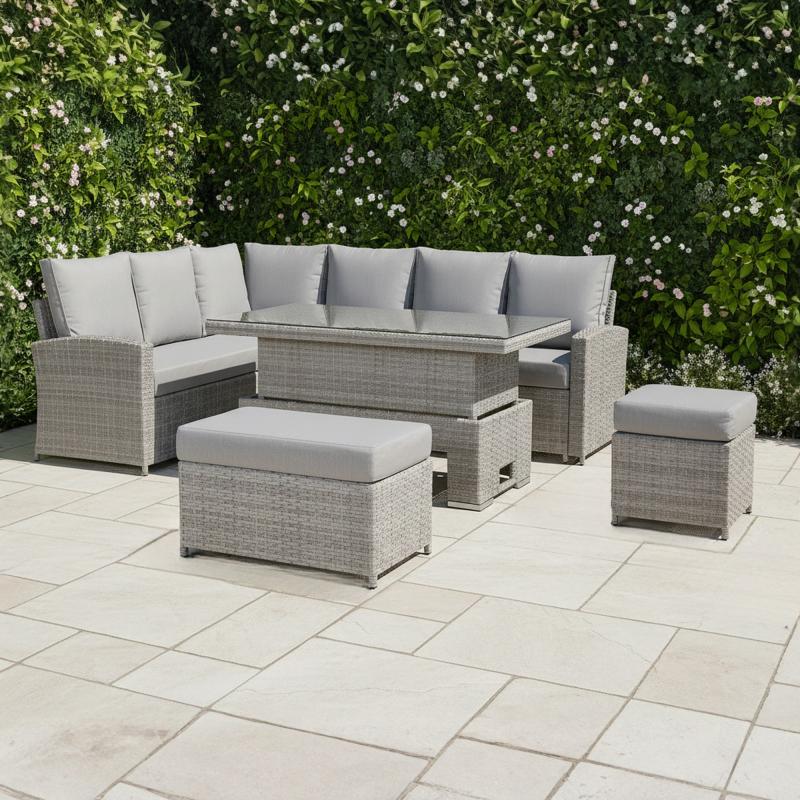Garden furniture trends for 2025
1. Indoor-Outdoor Fusion: This fusion trend is a fantastic concept for designing versatile, functional, and stylish spaces that seamlessly blend indoor and outdoor living. It’s ideal for individuals seeking to maximise space without compromising on design or comfort. The distinction between indoor and outdoor spaces is gradually fading, with furniture now reflecting the luxurious ambience of indoor living. Imagine plush sofas, high-backed armchairs, and elegant coffee tables, meticulously engineered to withstand the elements. Designers are also incorporating rich textures, such as woven upholstery and stone tabletops, to create a seamless transition between indoor and outdoor spaces. This trend particularly appeals to those who enjoy entertaining, enabling a cohesive flow between their living room and patio. Water-resistant materials like solution-dyed polyester and powder-coated metals make these luxurious designs practical for outdoor use.
2. Neutral tones: We’re anticipating a significant shift towards natural tones and materials such as wood and painted pebble finishes in 2025. These muted, neutral hues exude a serene and sophisticated aesthetic, ideal for outdoor spaces that prioritise natural beauty and a tranquil ambience. Pebble tones work seamlessly with various landscaping themes and styles, seamlessly blending with lush greenery or rustic outdoor elements. Incorporating plants and shrubs further enhances the connection between indoor and outdoor spaces, creating a harmonious and authentic environment.
3. Sustainable Materials: Eco-friendly garden furniture is a fantastic choice for those who want to reduce their environmental impact while creating a beautiful and sustainable outdoor space. In 2025, sustainability continues to be a key trend in garden design, and furniture made from eco-conscious materials is gaining popularity. Here are some eco-friendly options to consider for your garden. materials such as recycled wood, metal, and composite materials. These choices offer durability and a luxurious feel while minimising environmental impacts.
4. Modular Outdoor Kitchen Designs: An emerging trend is the desire among homeowners to integrate lounging and dining capabilities into their outdoor spaces. This trend can be attributed to the limited availability of sufficient space for both a dining set and a lounge set. Alternatively, it may stem from the preference for the comfort of a lounge while dining, particularly appealing to individuals who seek relaxation and conversation after meals. For instance, pairing a lounge set with a high-performance outdoor kitchen or barbecue can effectively achieve this integration. This combination enables outdoor dining experiences during the spring, summer and autumn months.
5. Technology Integration: Outdoor furniture is increasingly accommodating smart technology, with features that bring a whole new level of comfort, convenience, and style to outdoor spaces. With tech-enabled garden furniture, you can enjoy a fully immersive and customisable outdoor experience that adjusts to your preferences, making your garden more functional and enjoyable than ever before! These types of integrations include heat-resilient tabletops, charging ports, LED lighting, and audio speakers. This trend caters to those seeking functionality alongside comfort and you’ll find these features in garden pieces like parasols, pagolas and outdoor dining furniture.
6. Wellness-Oriented Spaces: Outdoor retreats are gaining popularity, with designs focusing on creating spaces that promote well-being. These retreats often include meditation nooks, yoga platforms, and outdoor spas. Water features and aromatic plants add to the sensory experience, creating a tranquil atmosphere.
7. Small-Space Furniture: With urban environments shrinking outdoor spaces, there’s a rising demand for compact and foldable garden furniture that can seamlessly fit in limited areas. Among our favourite on-trend pieces are nesting tables, folding bistros, and innovative storage tables, benches, and sofas. While the furniture doesn’t necessarily have to be small, its primary purpose is to fit and function effectively, maximising the use of available outdoor space.

